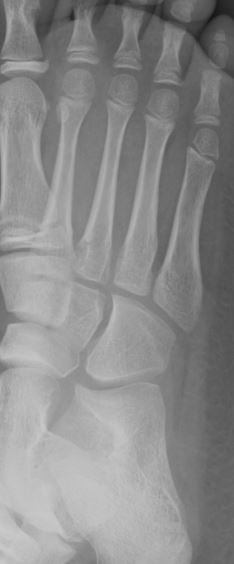

It is often misdiagnosed as an ankle sprain, and misdiagnosis can have serious consequences since sprains and fractures require different treatments. Since the big toe is used so frequently and bears more weight than other toes, arthritis in that area can make it painful to walk, bend, or even stand.Īnother type of break, called a Jones fracture, occurs at the base of the fifth metatarsal bone (behind the little toe). Certain kinds of fractures of the metatarsal bones present unique challenges.įor example, sometimes a fracture of the first metatarsal bone (behind the big toe) can lead to arthritis. Surgery often involves the use of fixation devices, such as pins.īreaks in the metatarsal bones may be either stress or traumatic fractures. If the break is badly displaced or if the joint is affected, surgery may be necessary.

The fractured toe to another toe is sometimes appropriate, but in other cases it may be harmful. Wearing a stiff-soled shoe protects the toe and helps keep it properly positioned. The toe may be fitted with a splint to keep it in a fixed position. Sometimes rest is all that is needed to treat a traumatic fracture of the toe. Treatment for traumatic fractures depends on the break itself and may include these options: Non-union, or failure to heal, can lead to subsequent surgery or chronic pain.įractures of the toe bones are almost always traumatic fractures. For example:Ī deformity in the bony architecture which may limit the ability to move the foot or cause difficulty in fitting shoesĪrthritis, which may be caused by a fracture in a joint (the juncture where two bones meet), or may be a result of angular deformities that develop when a displaced fracture is severe or hasn’t been properly corrected In fact, if a fractured toe or metatarsal bone is not treated correctly, serious complications may develop. Some people say that “the doctor can’t do anything for a broken bone in the foot.” This is usually not true. “Pinpoint pain” (pain at the site of the fracture) when touched

Pain that goes away when resting and then returns when standing or during activity They require proper medical attention to heal correctly. Improper footwear may also lead to stress fractures. They can also be caused by an abnormal foot structure, deformities, or osteoporosis. Stress fractures often afflict athletes who, for example, too rapidly increase their running mileage. It is not true that “if you can walk on it, it’s not broken.” Evaluation by a foot and ankle surgeon is always recommended.Īre tiny, hairline breaks that are usually caused by repetitive stress. “Pinpoint pain” (pain at the place of impact) at the time the fracture occurs and perhaps for a few hours later, but often the pain goes away after several hours.Ĭrooked or abnormal appearance of the toe. You may hear a sound at the time of the break. Signs and symptoms of a traumatic fracture include: If the fracture is displaced, the bone is broken in such a way that it has changed in position (dislocated). (also called acute fractures) are caused by a direct blow or impact, such as seriously stubbing your toe. Fractures can be divided into two categories: traumatic fractures and stress fractures. A foot and ankle surgeon should be seen for proper diagnosis and treatment, even if initial treatment has been received in an emergency room.Ī fracture is a break in the bone. Fractures of the toe and metatarsal bones are common and require evaluation by a specialist. Of the 26 bones in the foot, 19 are toe bones (phalanges) and metatarsal bones (the long bones in the midfoot). The structure of the foot is complex, consisting of bones, muscles, tendons, and other soft tissues.


 0 kommentar(er)
0 kommentar(er)
